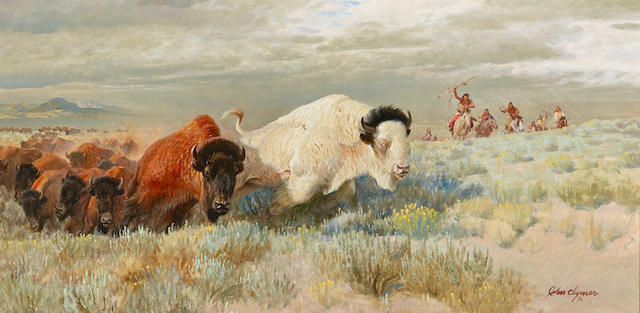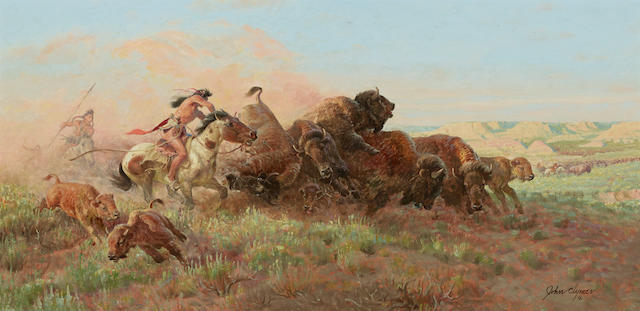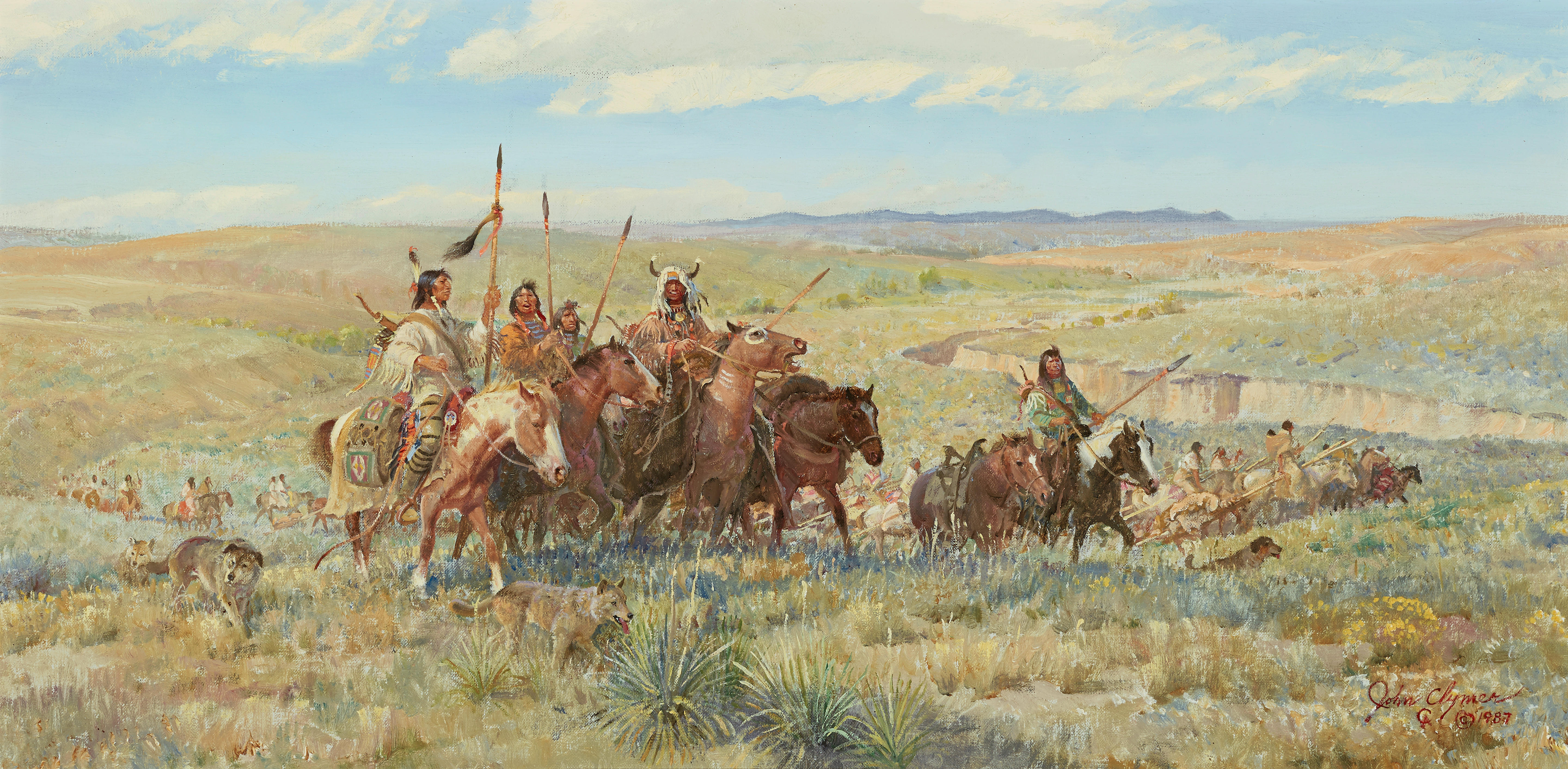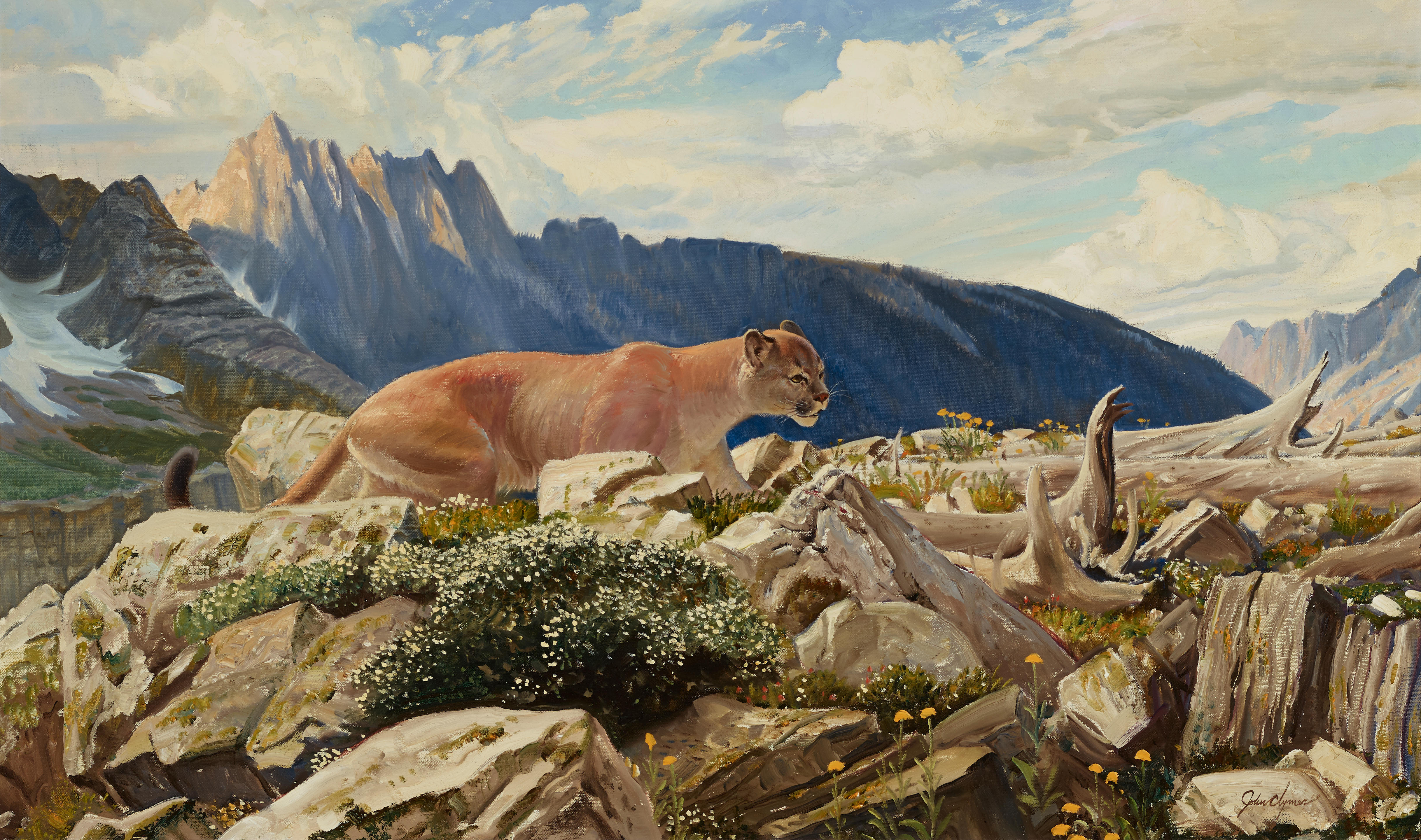John Ford Clymer (1907-1989) The Booshway signed and dated 'John Clymer CA © 73' (lower left), titled (on the cross brace) oil on canvas 24 x 40in Painted in 1973. Fußnoten Provenance The artist. Exhibited Phoenix, Phoenix Art Museum, Cowboy Artists of America 8th Annual Sale & Exhibition, September 14 - November 4, 1973, no. 17, exhibition checklist. Literature Phoenix Art Museum, Cowboy Artists of America 8th Annual Sale & Exhibition [exh. cat.], Flagstaff, Northland Press, 1973, p. 69. W. Reed, John Clymer, An Artist's Rendezvous with the Frontier West, Flagstaff, Northland Press, 1976, pp. 106-107, full page color illustration. P. Weaver, The Western Paintings of John Clymer, New York, Bantam Books, 1977, pl. 31, full page color illustration. John Ford Clymer was born and raised in Ellensburg, a small town in central Washington on the eastern slope of the Cascades, between the Columbia River and Mount Rainier National Park. This region provided many opportunities for the outdoor pursuits he loved as a child such as fishing, hiking and camping, but far fewer for art training and mentorship. His first exposure to art came vicariously through a magazine subscription salesman, where he saw illustrations by such artists as N.C. Wyeth and Frank Schoonover.1 As an earnest and self-motivated art student, Clymer sought training through the Federal School of Applied Cartooning, a home correspondence program. This program offered a Fundamentals of Art course, which included instruction by such artists as Charles Marion Russell and Maxfield Parrish The course provided Clymer with the feedback and confidence he needed to pursue commercial illustration work, first locally and then nationally—all while he was in high school.2 Upon graduation, Clymer furthered his art education by attending night school in Vancouver, Canada, while working as a freelance sign painter and for several magazines in Winnipeg and Toronto.3 Clymer took two important trips during this period: the first to the Yukon River, which provided source material for later illustrations of the Pacific Northwest, and the second to the Brandywine River area to visit one of his artist-heroes, Frank Schoonover. Encouraged by Schoonover, Clymer continued his studies in 1930 at the Wilmington Academy of Art where he was influenced by N.C. Wyeth and his students. In 1936, Clymer was living in Westport, Connecticut while attending the Grand Central School of Art and taking private classes with Harvey Dunn. After serving in World War II, Clymer began a twenty year career on the East Coast as a commercial illustrator for publications such as Field and Stream and The Saturday Evening Post in the early 1940s. In the course of his career he painted more than seventy cover illustrations for the Post alone, many of them western in subject. By the early 1960s, Clymer decided to pursue easel painting full-time, and his meticulous process of creating commercial illustration art turned instead toward compositions with a focus on Western History. Clymer moved to Jackson Hole, Wyoming in 1966 in order to be closer to the subjects of his work. He and his wife Alice "painstakingly research[ed] the subject of the painting, down to the smallest details of setting, climate, and historic period. After completing their research, they would then travel to the proposed site for the painting to get a firsthand feeling for the area."4 From this level of intense preparation, Clymer produced paintings rich in accurate historical detail, and with fidelity to the geographic setting, such as The Booshway. Clymer described his approach to his work: "I think it is the accumulation of all these experiences, the research and the old stories, the trips on the old trails to actual places, the visits to history museums, large and small, that make it possible to do pictures that are real and believable and have the feeling of the place and time."5 Clymer was an active member of the Cowboy Artists of America and recei
John Ford Clymer (1907-1989) The Booshway signed and dated 'John Clymer CA © 73' (lower left), titled (on the cross brace) oil on canvas 24 x 40in Painted in 1973. Fußnoten Provenance The artist. Exhibited Phoenix, Phoenix Art Museum, Cowboy Artists of America 8th Annual Sale & Exhibition, September 14 - November 4, 1973, no. 17, exhibition checklist. Literature Phoenix Art Museum, Cowboy Artists of America 8th Annual Sale & Exhibition [exh. cat.], Flagstaff, Northland Press, 1973, p. 69. W. Reed, John Clymer, An Artist's Rendezvous with the Frontier West, Flagstaff, Northland Press, 1976, pp. 106-107, full page color illustration. P. Weaver, The Western Paintings of John Clymer, New York, Bantam Books, 1977, pl. 31, full page color illustration. John Ford Clymer was born and raised in Ellensburg, a small town in central Washington on the eastern slope of the Cascades, between the Columbia River and Mount Rainier National Park. This region provided many opportunities for the outdoor pursuits he loved as a child such as fishing, hiking and camping, but far fewer for art training and mentorship. His first exposure to art came vicariously through a magazine subscription salesman, where he saw illustrations by such artists as N.C. Wyeth and Frank Schoonover.1 As an earnest and self-motivated art student, Clymer sought training through the Federal School of Applied Cartooning, a home correspondence program. This program offered a Fundamentals of Art course, which included instruction by such artists as Charles Marion Russell and Maxfield Parrish The course provided Clymer with the feedback and confidence he needed to pursue commercial illustration work, first locally and then nationally—all while he was in high school.2 Upon graduation, Clymer furthered his art education by attending night school in Vancouver, Canada, while working as a freelance sign painter and for several magazines in Winnipeg and Toronto.3 Clymer took two important trips during this period: the first to the Yukon River, which provided source material for later illustrations of the Pacific Northwest, and the second to the Brandywine River area to visit one of his artist-heroes, Frank Schoonover. Encouraged by Schoonover, Clymer continued his studies in 1930 at the Wilmington Academy of Art where he was influenced by N.C. Wyeth and his students. In 1936, Clymer was living in Westport, Connecticut while attending the Grand Central School of Art and taking private classes with Harvey Dunn. After serving in World War II, Clymer began a twenty year career on the East Coast as a commercial illustrator for publications such as Field and Stream and The Saturday Evening Post in the early 1940s. In the course of his career he painted more than seventy cover illustrations for the Post alone, many of them western in subject. By the early 1960s, Clymer decided to pursue easel painting full-time, and his meticulous process of creating commercial illustration art turned instead toward compositions with a focus on Western History. Clymer moved to Jackson Hole, Wyoming in 1966 in order to be closer to the subjects of his work. He and his wife Alice "painstakingly research[ed] the subject of the painting, down to the smallest details of setting, climate, and historic period. After completing their research, they would then travel to the proposed site for the painting to get a firsthand feeling for the area."4 From this level of intense preparation, Clymer produced paintings rich in accurate historical detail, and with fidelity to the geographic setting, such as The Booshway. Clymer described his approach to his work: "I think it is the accumulation of all these experiences, the research and the old stories, the trips on the old trails to actual places, the visits to history museums, large and small, that make it possible to do pictures that are real and believable and have the feeling of the place and time."5 Clymer was an active member of the Cowboy Artists of America and recei













.jpg)
.jpg)
Try LotSearch and its premium features for 7 days - without any costs!
Be notified automatically about new items in upcoming auctions.
Create an alert